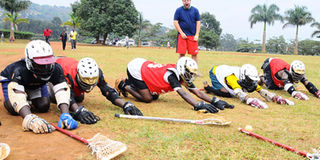Uganda’s newest sport targets 2014 WC in Colorado

HARDER: American Lacrosse trainer Bender shouts out instructions to the Ugandan team on July 30. PHOTO: ISAAC KASAMANI
There had been talk of a new sport in town but apart from seeking basic knowledge about it via Google, this writer had not come to terms with its entails hitherto – just like most of you.
An evening trip to Makerere University Business School (Mubs) sports grounds on a calm Saturday evening last week, however, banished some of the ignorance.
But more shock. Over 50 enthusiastic Ugandan youths are buried behind monstrous helmets, with elbows, chests and shoulders guarded to the marrow.
They wielded sticks in postures that would scare away even the most of hard-hearted robbers. The game? Lacrosse.
Lacrosse is a predominantly American sport formed as early as the 12th century by Red Indians.
But the name Lacrosse came about after French missionaries developed interest in the then primitive sport and began following and playing it with utmost dedication.
The game is played between two teams, with each side fielding 10 players – a goalkeeper, three defenders, three midfielders and three strikers. Each player carries a stick with a firm grip to enable tight handling. This stick has a basket-like net that allows players to collect the ball – the size of a tennis ball - to pass and to shoot at goal.
Lacrosse birth
Team members must strive to manoeuvre through the opponents’ territory – enduring checks on your stick and hands to force you drop the ball - until they reach the goalkeeper and score. Side with most goals wins the match.
But how did these chaps get to know the game introduced in Uganda just over two months ago? How did the sport come into the country, anyway?
“An American Lacrosse coach from Notre Damme College and a director of an NGO, Fields of Growth, Kevin Dugan, came to Uganda and mulled over the idea of introducing the sport,” said Uganda Lacrosse Union (USL) general secretary Maurice Sserunkuma.
The union were, thus, hastily formed to ease operations, according to Sserunkuma.
And they wouldn’t have got a better ambassador for chairperson than Davis Kamoga, a bronze medallist at the 1996 Summer Olympics in Atlanta, Georgia.
“So he involved us (Dugan) and we first went to Muk (Makerere University Kampala) but a lot of bureaucracy turned us away.
Making history
“That’s how we came to Mubs. Here we were welcomed and the administration took on our proposal immediately and the recruitment drive started.”
Sserunkuma added: “We have since recruited players, most of them University students here. We decided to take it to colleges first, we shall spread from there.
“From here we are going to Muk, Ndejje, UCU...and others.”
On the day for our visit to their training at Mubs, the team, who they call the Cranes, were being instructed by American coaches and players.
Michael Bender, who played high school lacrosse in the US and now volunteers for Fields of Work, did the most of centre coaching and refereeing.
Chad Wiedmaier, 21, and his brother Kiefer, 23, the former - a defender at Princeton University, New Jersey, and the latter - a midfielder at Providence College, played with the Ugandans.
History was made when the Federation of International Lacrosse (FIL) recognized Uganda as the 40th country in the world to have associate membership.
The clinic sponsored by the FIL at Mubs will culminate in the national championships on August 13, the first in Africa, intended to have a sense of which talent holds a future and to create awareness about the sport.
The dream the ULU are carrying for now is to participate in the 2014 World Championships in Denver, Colorado.
“It’s my dream, it’s everyone’s dream here to go to the World Championships,” said current Uganda team skipper Ibrahim Makanda.
Qualification for the 2014 World Championships in Colorado calls for at least one team from every continent and Uganda were the first to be accreditted from Africa.
Fortunately, the FIL have also taken it upon themselves to fully sponsor a Ugandan team of 40 players to the championships as a way of promoting the sport in the country, according to Sserunkuma.
The two-month old clinic that has trainings every Monday, Wednesday and Saturday evenings at Mubs grounds has already unearthed four teams – Panthers, Oneonta, Strykers and Warriors. These will compete against each other on the championships day.
Thereafter, a select Ugandan side will face off with an American outfit in an exhibition match to provide a thrilling finale to Uganda’s newest sport championships.
For now locally, ULU are getting support in terms of equipment and coaches from Fields of Cross and targeting more sponsors from within.
But like any young sport, more is needed from local sponsors if the baby is to have natural growth.
=======================================
Lacrosse fact file
World governing body: Federation of International Lacrosse
Nickname: Lax
First played: As early as the 12th century AD
Codified: 1867
Characteristics
Contact: Full contact
Team members: 10 at a time
Equipment: Lacrosse stick, helmet, shoulder pads, elbow pads, arm pads, gloves
Olympic: 1904–1908; (1928, 1932, and 1948 demonstration only)
The game...
Lacrosse is a team sport of Native American origin played using a small solid rubber ball and a long-handled stick called a crosse or lacrosse stick.
- Mainly played on the East Coast of the United States and Canada. The head of the lacrosse stick is strung with loose mesh designed to catch and hold the ball.
- Offensively, the objective of the game is to score by shooting the ball into an opponent’s goal, using the lacrosse stick to catch, carry, and pass the ball to do so.
- Defensively, the objective is to keep the opposing team from scoring and to dispossess them of the ball through the use of stick checking and body contact or positioning.
- The sport has four major types: Men’s field lacrosse, Women’s lacrosse, Box lacrosse and Intercrosse.
***Source...Google




